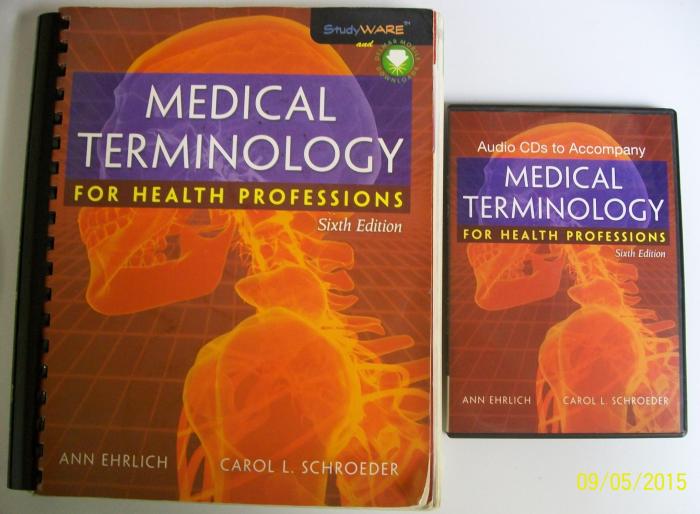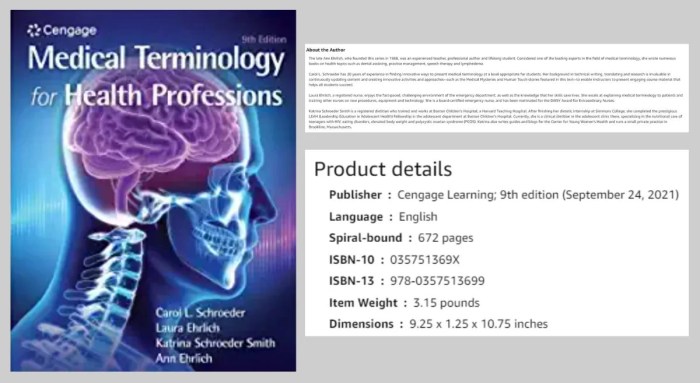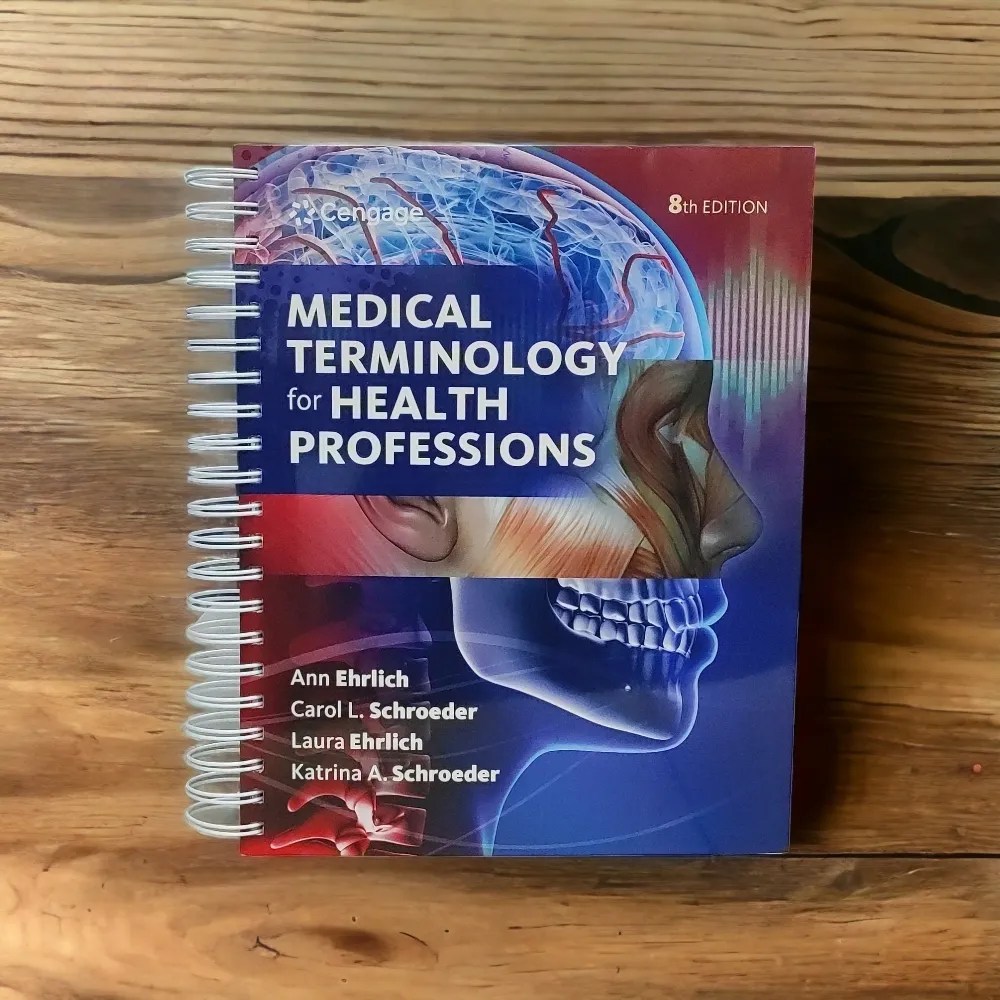Medical terminology for health professions 9th edition stands as a cornerstone of healthcare communication, providing a standardized language that empowers professionals to accurately document, diagnose, and treat medical conditions. This comprehensive guide delves into the intricacies of medical terminology, offering a systematic approach to understanding its structure, principles, and applications.
Throughout this exploration, readers will gain a deep understanding of anatomical, pathological, pharmacological, and procedural terminology, equipping them with the essential vocabulary and concepts required for effective healthcare delivery.
Terminology Basics

Medical terminology is a standardized language used by healthcare professionals to communicate about medical concepts and procedures. It provides a common vocabulary that ensures accurate and efficient communication, reducing errors and improving patient safety. Medical terminology is based on Greek and Latin roots, and it follows specific rules and principles that facilitate the understanding and usage of medical terms.
Medical terms are typically composed of a root word, which conveys the core meaning, and one or more suffixes or prefixes, which modify or expand the meaning of the root word. For example, the term “cardiologist” is derived from the Greek roots “cardio” (heart) and “logist” (specialist), indicating a specialist in heart conditions.
Medical terminology is organized into different categories, including anatomical, pathological, pharmacological, procedural, and diagnostic terminology. Each category has its own set of terms and principles that are used to describe specific aspects of healthcare.
Types of Medical Terms
- Anatomical termsdescribe the structure and location of body parts.
- Pathological termsdescribe diseases and disorders.
- Pharmacological termsdescribe drugs and their actions.
- Procedural termsdescribe medical procedures and techniques.
- Diagnostic termsdescribe tests and procedures used to diagnose diseases.
Anatomical Terminology
Anatomical terminology provides a standardized way to describe the human body and its structures. It is based on the anatomical position, which is a specific body posture used as a reference point for describing the location of body parts.
Anatomical terms are used to describe the direction, location, and relationship of body parts to each other. For example, the term “anterior” means towards the front of the body, while “posterior” means towards the back of the body.
Body Planes, Sections, and Cavities
- Body planesare imaginary lines that divide the body into sections. The three main body planes are the sagittal plane, the coronal plane, and the transverse plane.
- Body sectionsare slices of the body that are created by cutting through the body along a specific plane. The three main body sections are the cross section, the longitudinal section, and the oblique section.
- Body cavitiesare spaces within the body that contain organs and structures. The two main body cavities are the dorsal cavity and the ventral cavity.
Organization of the Human Body Systems
The human body is organized into a hierarchy of systems, each of which has a specific function. The eleven main body systems are the integumentary system, the skeletal system, the muscular system, the nervous system, the endocrine system, the cardiovascular system, the lymphatic system, the respiratory system, the digestive system, the urinary system, and the reproductive system.
Pathological Terminology

Pathological terminology is used to describe diseases and disorders. It provides a standardized way to communicate about the causes, symptoms, and treatment of diseases.
Pathological terms are often derived from Greek or Latin roots, and they follow specific rules for formation and usage. For example, the term “neoplasm” is derived from the Greek roots “neo” (new) and “plasma” (formation), and it refers to a new or abnormal growth of tissue.
Common Pathological Terms
- Inflammationis a response to injury or infection that involves redness, swelling, heat, and pain.
- Infectionis the invasion of the body by microorganisms, such as bacteria, viruses, or fungi.
- Neoplasmis a new or abnormal growth of tissue.
- Ulceris a break in the skin or mucous membrane.
- Abscessis a collection of pus in a body cavity.
Role of Medical Terminology in Disease Diagnosis and Treatment
Medical terminology is essential for accurate disease diagnosis and treatment. It allows healthcare professionals to communicate about the patient’s condition and to develop and implement appropriate treatment plans.
Pharmacological Terminology
Pharmacological terminology is used to describe drugs and their actions. It provides a standardized way to communicate about the dosage, administration, and effects of drugs.
Pharmacological terms are often derived from Greek or Latin roots, and they follow specific rules for formation and usage. For example, the term “analgesic” is derived from the Greek roots “an” (without) and “algesia” (pain), and it refers to a drug that relieves pain.
Principles of Pharmacological Terminology
- Generic nameis the official name of a drug, which is assigned by the United States Adopted Names Council (USAN).
- Trade nameis the brand name of a drug, which is assigned by the drug manufacturer.
- Dosageis the amount of a drug that is administered to a patient.
- Administration routeis the way in which a drug is given to a patient, such as orally, intravenously, or topically.
Importance of Accurate Drug Terminology in Patient Safety
Accurate drug terminology is essential for patient safety. It ensures that patients receive the correct drug, in the correct dosage, and by the correct route of administration. Errors in drug terminology can lead to serious adverse events, including death.
Procedural Terminology
Procedural terminology is used to describe medical procedures and techniques. It provides a standardized way to communicate about the steps involved in a procedure, the equipment used, and the potential risks and benefits.
Procedural terms are often derived from Greek or Latin roots, and they follow specific rules for formation and usage. For example, the term “appendectomy” is derived from the Greek roots “appendix” (appendix) and “ectomy” (removal), and it refers to the surgical removal of the appendix.
Types of Medical Procedures
- Diagnostic proceduresare used to diagnose diseases and conditions.
- Therapeutic proceduresare used to treat diseases and conditions.
- Preventive proceduresare used to prevent diseases and conditions.
Role of Medical Terminology in Patient Care and Documentation
Medical terminology is essential for effective patient care and documentation. It allows healthcare professionals to communicate about the procedures that have been performed, the equipment that was used, and the potential risks and benefits of the procedures.
Abbreviations and Acronyms

Abbreviations and acronyms are used extensively in medical terminology to save time and space. They are typically formed by combining the first letters of words in a term or phrase.
For example, the abbreviation “ECG” stands for “electrocardiogram,” and the acronym “ICU” stands for “intensive care unit.”
Importance of Abbreviations and Acronyms in Medical Terminology, Medical terminology for health professions 9th edition
- Efficiency: Abbreviations and acronyms save time and space, making it easier to write and read medical records.
- Clarity: Abbreviations and acronyms can help to clarify the meaning of medical terms, especially when used in combination with other terms.
- Consistency: Abbreviations and acronyms ensure consistency in medical terminology, reducing the risk of errors.
Potential Risks and Benefits of Using Abbreviations and Acronyms
- Ambiguity: Abbreviations and acronyms can be ambiguous, especially if they are not used consistently.
- Confusion: Abbreviations and acronyms can be confusing to patients and other healthcare professionals who are not familiar with them.
- Errors: Abbreviations and acronyms can lead to errors if they are not used correctly.
FAQ Section: Medical Terminology For Health Professions 9th Edition
What is the importance of medical terminology in healthcare professions?
Medical terminology provides a standardized language that ensures accurate communication, documentation, and treatment in healthcare settings.
What are the different types of medical terms?
Medical terms can be classified into anatomical, pathological, pharmacological, procedural, and abbreviations/acronyms.
How does medical terminology contribute to disease diagnosis and treatment?
Accurate medical terminology enables healthcare professionals to precisely describe and document symptoms, diagnoses, and treatment plans, facilitating effective communication and patient care.